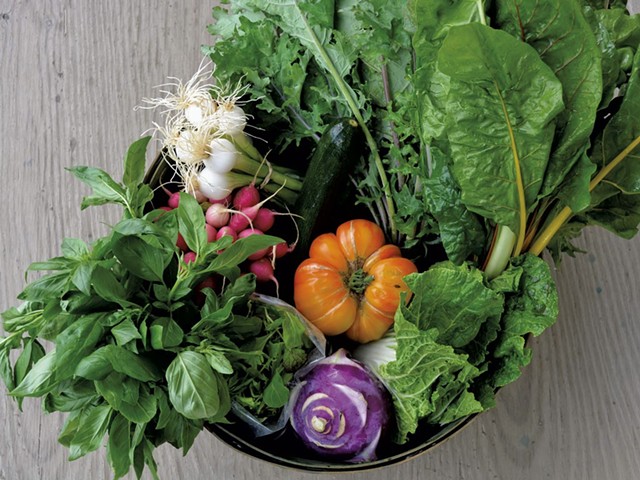Published April 7, 2020 at 10:00 a.m.
During World Wars I and II, people planted victory gardens in backyards and public parks. Originally organized as an effort to feed hungry people in World War I-devastated Europe, the National War Garden Commission — spearheaded by wealthy philanthropist Charles Lathrop Pack — encouraged Americans to sow idle land. Sprouting up in school grounds and vacant lots, these gardens provided fresh vegetables, fruits and herbs, but also strengthened community morale during challenging times. In 1942, an estimated 15 million American families planted gardens.
This spring, sow your own victory garden. Whether you till a sizable backyard plot or simply tend a flowerpot of fresh basil, those first green shoots will raise your family's spirits and remind you that spring is coming.
April isn't too late to start seedlings on a sunny windowsill. Cucumbers, beans and pumpkins are easy to start indoors. Herbs are also perfect for small pots. Chives, thyme and basil may be transplanted outside after all danger of frost has passed. Or just harvest them from pots all summer. As an added benefit, herbs give a savory fragrance to your home.
Planting seeds is simple. Follow individual packet directions to find out how deep to sow, water daily and keep in a sunny spot.
Order supplies by mail from two Vermont companies: High Mowing Organic Seeds in Wolcott offers free shipping on orders over $10. Gardener's Supply in Burlington and Williston started as a mail-order seed company in 1983 and now stocks nearly everything under the sun, from gardening tools to mud boots.
Supplies for Indoor Gardening
- Biodegradable peat pots — or improvise with individual yogurt containers or plastic cups
- Potting soil
- Seeds
- Craft or popsicle sticks to label the seeds planted in each pot
- A clean spray bottle to spritz your seeds — or water gently using a watering can
Crops to Consider
- Peas are traditionally the first seeds to plant when soil has thawed enough to mix in a little compost. They come in different varieties, from snow peas to shell peas to sugar snaps. To skip the trouble of erecting a fence for this vining plant, buy bush peas. These brushy plants won't need extra support.
- Radishes are quick growers and easy to harvest.
- For summer salads, sow a few rows of lettuce greens. Experiment with miniature heads of Tom Thumb butterhead, salad mixes or tender spring kale varieties.
Literacy Connections
- Essex, N.Y., writer Kate Messner authored Up in the Garden and Down in the Dirt. Christopher Silas Neal's illustrations show junior gardeners how a lush garden has a hidden world deep down in the earth.
- For the youngest gardeners, Eric Carle's The Tiny Seed follows the life cycle of a flower through a single seed.
Eat Local
- CSAs — community supported agriculture — offer weekly farm shares with fresh greens, potatoes, and root crops like beets and carrots. Many farms also offer meat, milk and cheese. Here's a selection of farms with CSAs. Contact farms in your area find out if they offer CSAs.
- In Craftsbury, Pete's Greens grows more than 200 vegetable varieties. With the mantra of "Vermont can feed itself," this four-season farm created its Good Eats CSA, with delivery in numerous counties.
- Intervale Community Farm in Burlington offers farm shares in different sizes and serves more than 600 families annually.
- Shelburne's Bread & Butter Farm produces homegrown veggies and meat.
- Wood's Market Garden in Brandon sells a summer CSA from its farm — with strawberries to come in June.
- Berlin's Dog River Farm feeds capital city residents with homegrown vegetables and fruits through its CSA and farmstand.
- Owned by third-generation Vermonters, Foote Brook Organic Farm in Johnson covers more than 100 acres and stocks a sizable roadside stand on busy Route 15.
This article was originally published in Seven Days' monthly parenting magazine, Kids VT.
More By This Author
Speaking of...
-

A Young Couple Relocated 3,000 Miles to Buy a Legacy Vegetable Farm in Brandon
Sep 12, 2023 -

Best CSA
Aug 2, 2023 -

At Dog River Farm in Berlin, a One-Day Flood Wipes Out a Season’s Labor
Jul 19, 2023 -

'Visionary' Vermont Entrepreneur Will Raap Dies at 73
Dec 13, 2022 -

Best CSA
Aug 3, 2022 - More »
Comments
Comments are closed.
From 2014-2020, Seven Days allowed readers to comment on all stories posted on our website. While we've appreciated the suggestions and insights, right now Seven Days is prioritizing our core mission — producing high-quality, responsible local journalism — over moderating online debates between readers.
To criticize, correct or praise our reporting, please send us a letter to the editor or send us a tip. We’ll check it out and report the results.
Online comments may return when we have better tech tools for managing them. Thanks for reading.















































